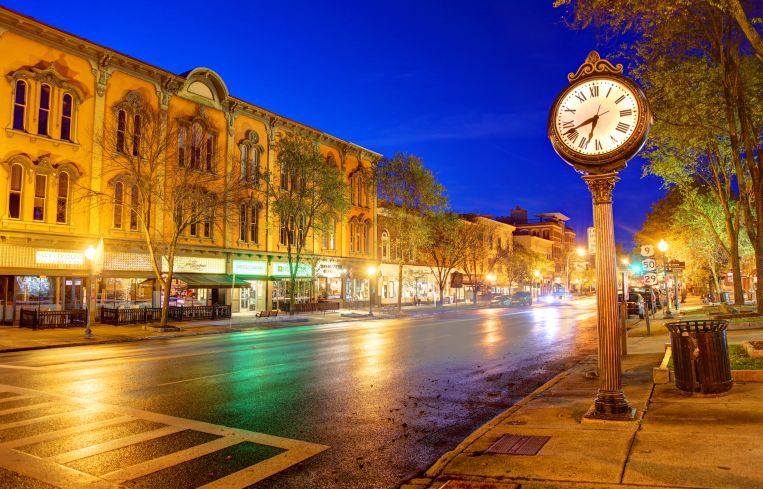Presented By: Adirondack Capital Partners
Why Institutional Capital Is Flocking to Saratoga County’s Multifamily Market
by Michael Hunter Coghill, Managing Partner, Adirondack Capital Partners
By Adirondack Capital Partners September 16, 2025 9:58 am
reprints
For decades, institutional capital followed a predictable script: Buy in gateway markets, lean on brand-name cities, and treat anything outside the top 10 MSAs as flyover territory. But capital is smarter now — more agile, more global and more interested in real economic growth than branding.
That shift is playing out dramatically in one of the most unexpected places: Saratoga County, New York.
Over the past three years, this once-seasonal market has transformed into the dominant player in Upstate New York’s investment sales landscape. Since 2021, the county has recorded over $1.1 billion in multifamily transactions over $20 million — 10 of which were represented by our firm, Adirondack Capital Partners (ACP). We hold a commanding 66.5 percent market share in this high-value segment, but the story is much bigger than any one firm.
Saratoga County is becoming a model for how secondary markets can behave like core. Investors — both domestic and foreign — are catching on fast.
From mineral springs to microchips
At the heart of this transformation is a powerful convergence of factors: high-paying job growth, disciplined development, legacy infrastructure and a uniquely appealing quality of life.
GlobalFoundries’ $15 billion Fab 8 facility in Malta put Saratoga on the semiconductor map. Now, the company is doubling down with a second fab of equal size, bringing 1,000-plus new jobs and positioning the county as a critical node in America’s chipmaking supply chain. At the same time, Regeneron has planted a 1 million-square-foot flag to support its growing biotech manufacturing footprint.

These aren’t just corporate expansions — they’re economic gravity wells. And they’re attracting a new class of investor: one that sees long-term value in real job absorption, population inflow and stable rent growth.
Local governments have amplified that appeal by streamlining approvals and investing in infrastructure without compromising fiscal discipline. You get the pro-business posture of the Sun Belt, but in a location with 150-year-old tourism infrastructure, elite schools and walkable downtowns.
Institutional capital is already here
Saratoga’s rise isn’t theoretical — it’s validated by hard numbers and institutional dollars.
Just look at recent trades: Winner’s Circle Apartments ($180 million), Northway Eleven Communities ($100 million) and Fox Run ($82 million). Cap rates on these deals remain in the low to mid-5s, even as borrowing costs rise and cap rates expand in peer markets. That’s a rare signal in today’s capital markets: visible liquidity, durable fundamentals and investor confidence.
These aren’t one-off wins. They’re part of a growing portfolio of large-scale multifamily and mixed-use assets trading at institutional volume, with proven exit strategies. At ACP, our current pipeline includes more than $225 million in exclusive listings across Saratoga and the broader Capital Region. Even in a choppy interest rate environment, buyer interest remains high.
Why foreign investors are betting big
As we noted in our earlier report, global capital is increasingly bypassing gateway volatility in favor of long-term, fundamentals-driven growth. That’s why we’re seeing Japanese, Israeli and European investors dive into Upstate New York — places they wouldn’t have considered five years ago.
They’re not just chasing yield. They’re chasing visibility — into jobs, income and absorption. Foreign investors want to purchase in regions where they can hold assets for 10, 15, 20 years and know the story will only get better.
Most recently, we advised an Israeli group on a 212-unit acquisition in Saratoga, its first move into the region. That wasn’t a trial run. It was a strategic stake. Today, we’re working on similar cross-border transactions from Albany to Rochester, leveraging our firm’s deep ties in Japan and the Gulf to connect foreign capital with real U.S. opportunity.
Strong demographics, tight supply, real rent growth
The fundamentals are textbook.
Median household income in Saratoga exceeds $88,000. Vacancy is below 3.5 percent. Annual rent growth ranges from 4 to 6 percent, driven by a blend of in-migration, high-wage job creation and limited new supply. The market isn’t overbuilt or overleveraged. It’s disciplined, healthy and absorbing new residents faster than many urban cores.
Layer on the summer economy — the Saratoga Race Course brings in over 1 million visitors and $200 million in seasonal impact — and you get a hospitality and retail sector that reinforces demand for multifamily and mixed-use while stabilizing the local hospitality and retail businesses.
A boutique model in a global market
At ACP, we’ve always believed that the most compelling deals sit just outside the spotlight. Our model was built for this moment: boutique focus, institutional execution, and global reach.
We’re deliberately focused on two verticals: large-scale multifamily in the Northeast and high-street assets in global cities like New York, Boston and Miami. That allows us to serve family offices and global institutions with equal fluency — and to match the right capital to the right asset, every time.
Our strength is anticipating where capital is going, not just where it’s been. In Saratoga, that means connecting long-term investors with a market that looks less like a secondary play and more like a Northern Austin or Raleigh — high-tech jobs, historic charm and real liquidity.
What comes next
Saratoga County isn’t a one-time story. It’s a blueprint.
The Northeast has plenty of legacy cities with struggling downtowns and oversupplied assets. Saratoga shows what’s possible when a market gets it right: pro-growth leadership, diverse economic anchors and just enough development discipline to keep supply in check.
That’s why capital is flowing here — from Manhattan, from Munich, from Tokyo. And it’s why we believe Saratoga isn’t just the future of Upstate New York — it’s the new benchmark for what a modern secondary market can be.



